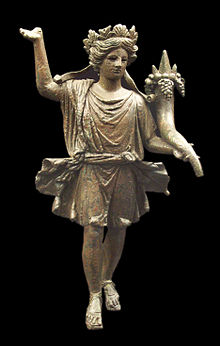
Back لار (آلهة) Arabic Lares AST Лары (міфалогія) Byelorussian Лари (митология) Bulgarian Lar Catalan Larové Czech Lar Danish Laren German Λάρητες Greek Lares (mitología) Spanish

Lares (/ˈlɛəriːz, ˈleɪriːz/ LAIR-eez, LAY-reez,[1] Latin: [ˈlareːs]; archaic lasēs, singular lar) were guardian deities in ancient Roman religion. Their origin is uncertain; they may have been hero-ancestors, guardians of the hearth, fields, boundaries, or fruitfulness, or an amalgam of these.
Lares were believed to observe, protect, and influence all that happened within the boundaries of their location or function. The statues of domestic Lares were placed at the table during family meals; their presence, cult, and blessing seem to have been required at all important family events.
Roman writers sometimes identify or conflate them with ancestor-deities, domestic Penates, and the hearth.
Because of these associations, Lares are sometimes categorised as household gods, but some had much broader domains. Roadways, seaways, agriculture, livestock, towns, cities, the state, and its military were all under the protection of their particular Lar or Lares. Those who protected local neighbourhoods (vici) were housed in the crossroad shrines (Compitalia), which served as a focus for the religious, social, and political lives of their local, overwhelmingly plebeian communities. Their cult officials included freedmen and slaves, otherwise excluded by status or property qualifications from most administrative and religious offices.
Compared to Rome's major deities, Lares had limited scope and potency, but archaeological and literary evidence attests to their central role in Roman identity and religious life. By analogy, a homeward-bound Roman could be described as returning ad Larem (to the Lar). Despite official bans on non-Christian cults from the late fourth century AD onwards, unofficial cults to Lares persisted until at least the early fifth century AD.
